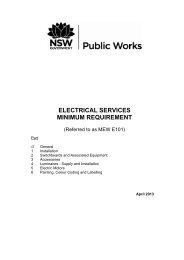electrical services minimum requirement - NSW Public Works
electrical services minimum requirement - NSW Public Works
electrical services minimum requirement - NSW Public Works
Create successful ePaper yourself
Turn your PDF publications into a flip-book with our unique Google optimized e-Paper software.
Part 1 - Installation<br />
110 CABLE TRAY, LADDER AND TROUGHING<br />
110.1 Generally<br />
110.2 Cable Tray<br />
Cable tray, cable ladder and all accessories shall be proprietary items from a single<br />
manufacturer whose range includes splice connections, expansion splices, covers, risers,<br />
crossovers, reducers, bends and all other accessories used. Supply covers<br />
manufactured from the same material as the tray or ladder up to 2000 above finished<br />
floor level.<br />
Cable tray shall be manufactured from steel, hot dip galvanised after fabrication or from<br />
aluminium or stainless steel.<br />
Minimum thickness for cable tray shall be:<br />
1mm up to 150 wide 1.6 for aluminium<br />
1.2 mm from 150 up to 300 wide 2 for aluminium<br />
1.6 mm above 300 wide 2.6 for aluminium<br />
All cable trays shall be slotted similar to "Admiralty" pattern and shall have folded or rolled<br />
edges. The "standard" tray shall be formed with the perforations punched from outside<br />
the folded edge to avoid any sharp edges or burrs existing on the outside face. The<br />
"reverse" tray shall be perforated from the inside and shall be used in positions where<br />
cables are laid horizontally in the tray or alternatively, trays shall have the metal<br />
reinforced by folding to provide equivalent stiffness.<br />
Cable trays installed externally must be aluminium or stainless steel.<br />
110.3 Cable Ladder<br />
110.4 Installation<br />
Cable ladder shall consist of two folded steel or extruded structural grade aluminium side<br />
rails with cable support rungs between the two rails. The rungs shall be either welded or<br />
fitted to the side rails.<br />
Unless otherwise indicated rung spacing shall not exceed 300. Cables smaller than 13<br />
OD installed on cable ladder shall be run on perforated tray or ducts installed on the<br />
ladder. This <strong>requirement</strong> does not apply where the rungs of the ladder form a continuous<br />
base.<br />
Cable tray and ladder shall be installed by either:<br />
(a) surface fixing to ceilings or walls; or<br />
(b) suspending by hangers from ceilings, or by angle brackets out from walls.<br />
Fixings, hangers and angle brackets are to be spaced at a maximum distance of 1000.<br />
Joints shall be adequately supported.<br />
Where possible, cable tray and ladder shall not be mounted less than 2300 above floor<br />
level. Adequate access shall be provided to cable tray and ladder. Where supported by<br />
hangers or angle brackets, a <strong>minimum</strong> distance of 150 shall be allowed above and 600<br />
on one side of the tray or ladder.<br />
Alternative systems and supports with greater spacing may be accepted if they give equal<br />
rigidity and strength.<br />
Where cable tray or ladder span open areas they shall be capable of supporting an<br />
additional load of 70kg at mid span without permanent deformation.<br />
Cables or groups of cables shall be securely strapped to the tray or ladder using<br />
proprietary nylon cable ties or straps: for vertical runs at 1000 maximum; for horizontal<br />
runs at 2000 maximum.<br />
Cables shall leave the cable tray or ladder in such a manner that no cable shall be in<br />
contact with the side rails. In general, cable shall leave the tray or ladder in conduit,<br />
Page 20 MEW E101





